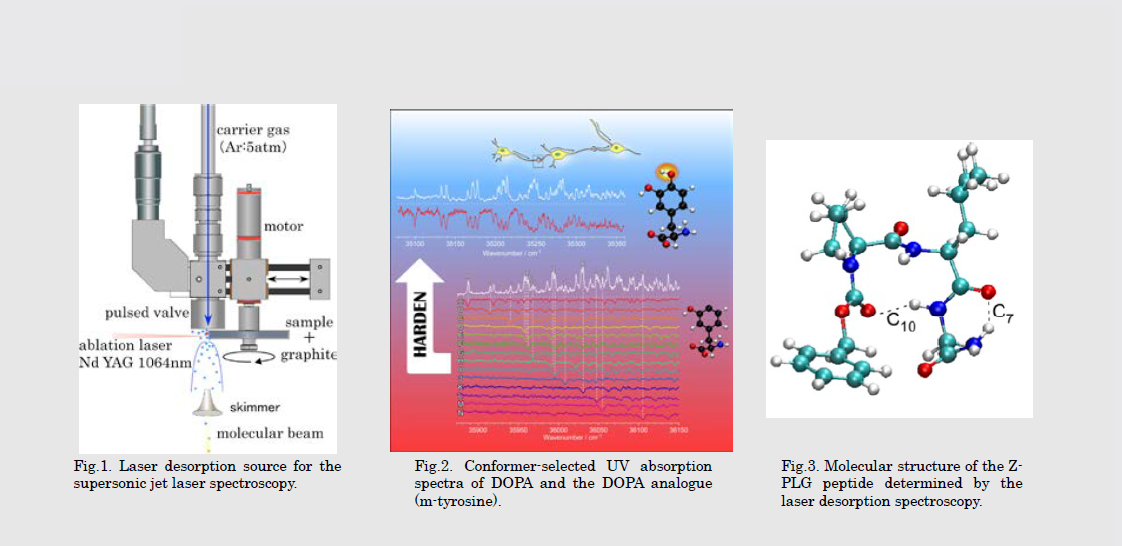CLS
Laboratory for Chemistry and Life Science, Institute of Innovative Research, Tokyo Institute of Technology
東京工業大学
科学技術創成研究院
化学生命科学研究所

LAST UPDATE 2020/06/11
-
研究者氏名
Researcher Name藤井正明 Masaaki FUJII
教授 Professor -
所属
Professional Affiliation東京工業大学科学技術創成研究院化学生命科学研究所
分子機能化学領域
Laboratory for Chemistry and Life Science, Institute of Innovative Research, Tokyo Institute of Technology
Molecular functions -
研究キーワード
Research Keywords先端レーザー分光
分子認識
生体分子システム
気相分光
Advanced Laser Spectroscopy
Molecular recognition
Biological moleculer systems
Gas phase spectroscopy
- 研究テーマ
Research Subject -
複合分子ビルディングブロックの光機能・ナノ空間機能解析
Study on optical functions and nano-space interactions of molecular building blocks in complex systems
研究の背景 Background
超分子や生体分子は複数の分子が巧妙に複合して極限的な分子機能を実現しています。たとえば神経伝達過程では受容体と呼ばれる大きなタンパク質がアドレナリンなど特定の神経伝達物質だけを鍵と鍵穴の関係に例えられるほど選択的に分子認識することで機能しています。分子認識を代表とする精密な機能発現のメカニズムを分子同士の相互作用の観点から明らかにすることは、自己組織化などを利用する高機能材料創製や創薬など化学およびそれに関係する広い領域の基礎であり、その理解が求められています。
Supramolecules and biomolecules have molecular functions of ultimate efficiencies. For example, the receptor protein recognizes a specific neurotransmitter (e. g. adrenaline) precisely just like “lock and key”. The mechanism of the ultimate functions such as the moleculer recognition can be understood from the view point of the intermolecular interactions. The deep understanding of the mechanism at the moleculer levels is desired because of its importance in chemistry and the related field such as the basic principle for the selforganization to develop the highly functional materials and medicines.
研究の目標 Outcome
独自に開発したレーザー蒸発法など新たな気相レーザー分光法を用いて神経伝達物質や受容体の分子認識部位(部分ペプチド)など高度な分子認識を実現している機能性分子(ビルディングブロック)の構造とダイナミクスを明らかにする。特にこれらの分子は単結合が多い柔らかな分子であり、取りうるコンフォメーションをまず明らかにする必要がある。最終的には受容体の分子認識部位と神経伝達物質のような分子認識に関わる分子クラスターを形成させ、その結合構造から分子認識メカニズムを明らかにする。
Structures and dynamics of functional molecules (building blocks), which concern novel molecular recognitions such as neurotransmitters and partial peptides of receptors, are studied by using originally developed laser desorption spectroscopy in gas phase. Particularly possible conformations of the building blocks are investigated because of their flexibility. From the intermolecular structures of complex at the molecular recognitions, such as the partial peptides of the receptor pocket and neurotransmitters, the mechanism of the molecular recognitions will be revealed.
研究図Research Figure

文献 / Publications
S. Ishiuchi et al., Chem. Phys., 419, 145 (2013), Y. Shimozono et al., Phys. Chem. Chem. Phys., 15(14), 5163 (2013), S. Ishiuchi et al., Phys. Chem. Chem. Phys., 13, 7812 (2011), S. Ishiuchi et al., J. Phys. Chem. A 115, 10363 (2011), H. Mitsuda, et al.,J. Phys. Chem. Lett. 1, 1130 (2010),
研究者HP
- mfujii
 res.titech.ac.jp
res.titech.ac.jp - http://www.csd.res.titech.ac.jp/indexj.html